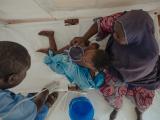May 9, 2011 (CIDRAP News) – An epidemiologic study by French researchers of the initial days of Haiti's cholera outbreak builds a stronger argument linking the importation of the bacteria to the arrival of United Nations (UN) peacekeepers from Nepal than a recent report from the UN's independent experts did.
News of the group's findings was leaked to the media in early December 2010, and the full findings appeared May 6 in an early online posting by Emerging Infectious Diseases (EID). The report details a field investigation conducted by the French researchers and their colleagues with Haiti's health ministry.
On May 4 an independent expert group working on behalf of the UN issued the results of its 5-month investigation into the source of Haiti's cholera outbreak, which stopped short of blaming Nepalese UN peacekeepers. The group said the evidence overwhelmingly supported human activity as the source but that the pathogen couldn't have spread without deficiencies in Haiti's water, sanitation, and health systems.
So far Haiti's cholera count is 285,931 cases, including 4,870 deaths, according to the latest report from the Pan American Health Organization (PAHO).
When the outbreak first surfaced, some public health officials thought the contamination could be related to the massive earthquake that had occurred in January 2010. However, rumors also circulated that sick Nepalese soldiers imported the disease into Haiti and dumped sewage into the Artibonite River. As other theories emerged to explain Haiti's first cholera outbreak in nearly a century, an early analysis suggested that the Vibrio cholerae strain was from outside Haiti, perhaps from southern Asia or eastern Africa.
The investigators reported that Nepal's capital, Kathmandu, reported a cholera outbreak in September 2010, shortly before the UN soldiers departed for Haiti.
In the French and Haitian investigation, researchers built a database early in the outbreak, which began in mid October 2010, to identify clusters and analyze the disease's rapid spread in Artibonite department. They did field interviews with health groups and government officials and explored environmental risks in communities and cholera treatment centers.
They found that the first patients were a family living in Meille, a village that hosted a UN peacekeeping camp located above a stream that flowed into the Artibonite River. Nepalese soldiers began arriving at the location shortly before the family got sick. Haitian epidemiologists had observed that a pipe from the camp discharged sewage into the stream, which villagers used for cooking and drinking.
Soon afterward, cholera illnesses were detected in Mirebalais, where local people used water from the river while their water system underwent repair. Prisoners at a facility that obtained drinking water from the river were also sickened
The researchers noted that cholera cases dropped soon after sanitary problems at the UN camp were corrected, but then spiked again in November.
The outbreak was explosive in communities along the Lower Artibonite River and then spread into the Artibonite Basin, they reported.
The investigators wrote that the remoteness of Meille and the absence of other newcomers "make it unlikely that a cholera strain might have been brought there another way." They added that DNA genotyping suggests the source was point contamination from a distant source.
They suggested that sewage from asymptomatically infected soldiers probably wouldn't have created a large enough infectious dose to cause severe illnesses downstream, and said they believe symptomatic cholera infections occurred among the Nepalese soldiers inside the UN camp.
"Whatever its cause, this violent outbreak in Lower Artibonite provoked the flight of persons and resulted in a wave of epidemics that spread centrifugally and overwhelmed the nascent sanitarian response," the article states. "This wave explains the difference between the delayed and progressive starting of epidemics in the south and the immediate impact of cholera in the north."
The report shows the usefulness of accurate field reporting to help focus response efforts, especially when an outbreak involves a newer pathogen or develops quickly, the researchers said.
Though the epidemiologic report doesn't pinpoint the exact contamination event, the findings serve as a reminder that military camp sewage should be handled properly and that aid organizations should avoid adding risks that don't already exist, they emphasized.
In an editorial in the same issue of EID, Dr Scott Dowell and Dr Christopher Braden, both from the US Centers for Disease Control and Prevention (CDC), wrote that the French and Haitian study provides circumstantial evidence that fecal contamination of a stream initiated the outbreak, and that the Nepalese soldiers might have been the source. Dowell directs the CDC's division of global disease detection and emergency response, and Braden is a medical epidemiologist who directs the CDC's division of foodborne, waterborne, and environmental diseases.
Though the spread within days to remote parts of Haiti suggests travel of infected patients played a role in spreading the outbreak, "there is little doubt that the organism was introduced to Haiti by a traveler from abroad, and this fact raises important public health considerations," they wrote.
Public health experts have noted that Haiti was vulnerable because its population was naive to the disease, but Dowell and Braden said the pathogen did not cause major outbreaks in other countries, such as the Dominican Republic, that reported cases linked to Haiti's cholera outbreak. They wrote that improving water and sanitation conditions is Haiti's best hedge against future cholera outbreaks.
They lauded the public health response, which in about 4 months helped reduce cholera mortality to less than 1%. "Even as we continue to learn more about the intercontinental spread of this ancient human scourge, we are reminded of the continued effectiveness of traditional public health control measures," the two conclude.
See also:
May 6 Emerg Infect Dis study
May 6 Emerg Infect Dis editorial
May 3 PAHO update
May 5 CIDRAP News story "Experts link Haiti cholera outbreak to human actions, foreign strain"
Dec 8, 2010, CIDRAP News story "Experts disagree on Haiti cholera source as cases near 100,000"


















